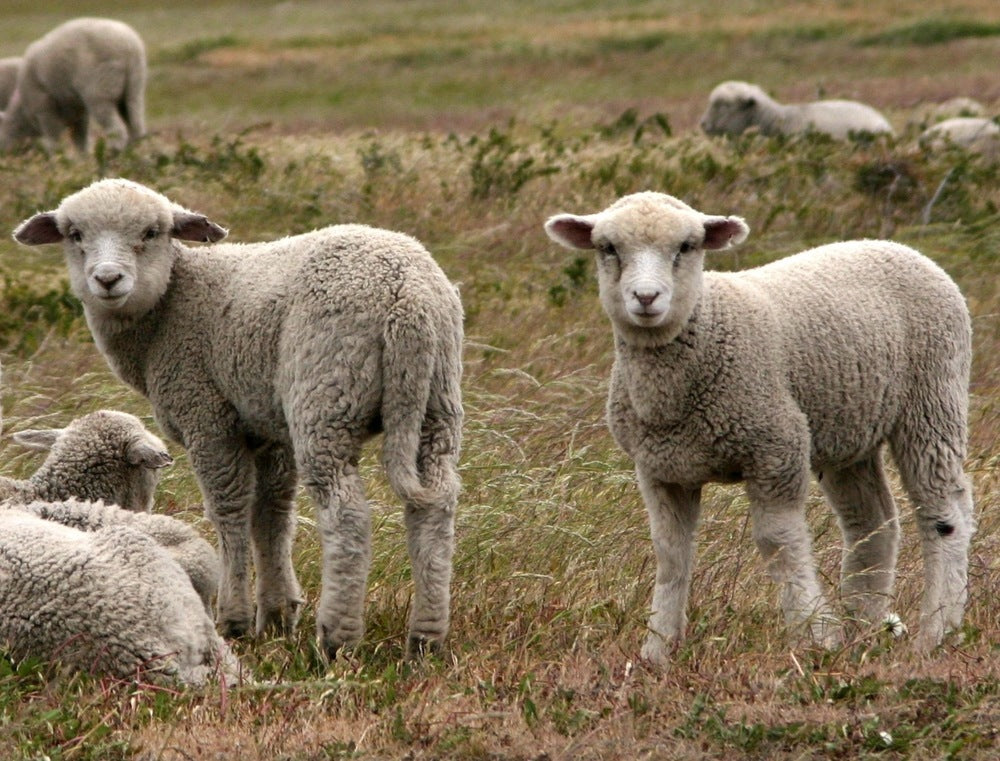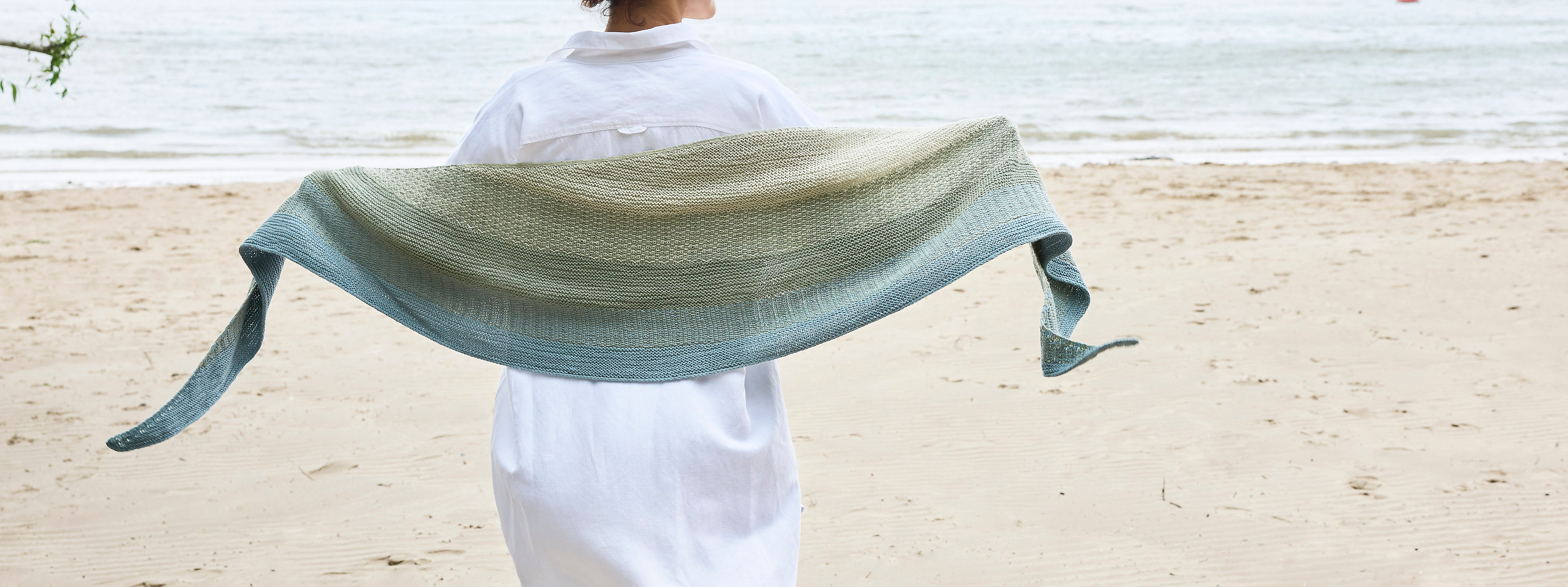Rosys Tipps zum Waschen von Wolle
Ich persönlich wasche meine Strickstücke am liebsten von Hand. Das habe ich mir angewöhnt, weil wir in unserem Mehrfamilienhaus in der Stadt lange Zeit eine uralte Gemeinschaftswaschmaschine hatten, deren Temperatureinstellungen ich nicht über den Weg traute. Inzwischen haben wir eine neue, die ich aber trotzdem nicht oft für Strickstücke benutze. Weil Merinowolle grundsätzlich nur ganz selten gewaschen werden muss – eine von vielen tollen Eigenschaften, die ich an ihr so liebe.
Wolle in der Maschine waschen?
Wolle in der Waschmaschine waschen, geht das überhaupt? Die Antwort ist einfach: Nur wenn es auf dem Etikett steht. Denn dazu muss die Wolle vom Hersteller mit einer Antifilzausrüstung versehen worden sein, sonst verfilzt sie in der Maschine. Stark vereinfacht kannst du dir das so vorstellen: Beim Verfilzen bilden viele abstehende Wollfasern durch Reibung einen dicht miteinander verhakten Verbund. Bei einem Garn mit Antifilzausrüstung ist die Oberfläche glatter und es stehen kaum Fasern ab, die sich sich beim Reiben und Schleudern in der Maschine miteinander verhaken können.
Unsere Cheeky Merino Joy, Lovely Merino Treat und Big Merino Hug sind maschinenwaschbar. Sie sind - im Gegensatz zu konventionell hergestellter maschinenwaschbarer Wolle (auch superwash Wolle genannt) - mit einem nach GOTS-zertifizierten Verfahren ganz ohne Chlor maschinenwaschbar gemacht worden. Das spart viele Tonnen Wasser und schont die Umwelt.
Unsere anderen Garne Manx Merino Fine und Merino d'Arles solltest du nicht in der Maschine waschen, da sie Fasern ohne Antifilzausrüstung enthalten.
Wie oft sollte ich mein Strickstück waschen?
Mit Merinowolle sparst du dir eine ganze Menge Arbeit und entlastest gleichzeitig die Umwelt. Merinowolle ist nämlich geruchsausgleichend. Du kannst sie einfach öfter mal nur an der frischen Luft auslüften lassen. Unangenehme Gerüche verschwinden so meist ganz von alleine, ohne hohen Wasser- und Stromverbrauch. Baumwolle hingegen - denke zum Beispiel an deine T-Shirts - besitzt nicht diese wunderbare Eigenschaft, so dass du sie viel häufiger waschen musst.
Weniger waschen hat noch einen Vorteil: Es schont deine Lieblingsstücke und verlängert ihre Lebensdauer. Und wenn es dann doch sein muss, verlieren unsere Farben durchs Waschen nicht an Intensität. Wir haben uns für chemische Bio-Farben mit hoher Haltbarkeit entschieden, damit du lange Freude an deinen gestrickten Kostbarkeiten hast.
Warum sollte ich manche Strickstücke schon vor dem ersten Tragen waschen?
Manche glatt rechts gestrickten Oberteile oder Tücher im Lace-Muster entfalten erst nach dem sogenannten Spannen (oder Blocken) ihre volle Schönheit. Der Effekt des Spannens ist ein gleichmäßigeres, glatteres Maschenbild. Außerdem kannst du damit die Proportionen und Größe des Strickstücks noch ein wenig verändern oder spezielle Konturen gestalten, wie zum Beispiel den gezackten Rand eines Tuchs. Dazu wäschst du das Strickstück und spannst es im feuchten Zustand mit Stecknadeln oder anderen Spannhilfen auf einen flachen Untergrund. Bei kleinen Stücken wie Mützen oder Handschuhen, einem kraus rechts gestrickten Schal oder bestimmten Mustern wie zum Beispiel Zopfmuster, ist Spannen nicht nötig.
Welches Waschmittel ist das richtige?
Voll-, Bunt-, Fein- oder besser ein Spezialwaschmittel? Wichtig ist, dass du ein spezielles Wollwaschmittel verwendest, am besten in Bio-Qualität ohne künstliche Zusätze, und ohne Weichspüler. Sicher kannst du sein, wenn auf der Verpackung „Wollwaschmittel“ steht oder zumindest erwähnt wird, dass es sich für Wolle bzw. Strickstücke eignet. Sonst kann es sein, dass dein geliebtes Strickstück verschleißt, verfilzt oder Knötchen (Pilling) bildet.
Meine Schritt-für-Schritt Wasch-Anleitung:
Diese Vorbereitung gilt für Hand- und Maschinen-Wäsche:
- Falls möglich (zum Beispiel bei Pullover oder Mütze), drehe die Innenseite des Strickstücks nach außen.
- Wasche Strickstücke nie zusammen mit schweren, robusten Kleidungsstücken wie Jeans oder Kleidung mit Reißverschlüssen oder Ösen, die sie beschädigen könnten.
- Verwende ein spezielles Wollwaschmittel.
Bei Maschinenwäsche:
- Sieh auf dem Etikett der Wolle nach, zu welcher Temperatur und welchem Waschprogramm der Hersteller rät. Bei unserer Merinowolle sind es 30 Grad im Wollwaschgang. Dieser Waschgang weist eine besonders schonende mechanische Behandlung auf.
- Fülle die Waschtrommel höchstens bis zu einem Drittel.
- Wähle eine möglichst niedrige Schleuderzahl, denn starkes Schleudern strapaziert die Wolle und kann sie beschädigen.
Bei Handwäsche in einer Schüssel oder im Waschbecken:
- Das Wasser darf höchstens lauwarm sein - im Zweifel lieber zu kühl als zu warm.
- Weiche dein Werk vorsichtig ein. Diesen Teil mag ich besonders, weil sich die Wolle im Wasser butterweich anfühlt. Aber Achtung, nass ist sie am empfindlichsten. Du solltest sie deshalb niemals stark kneten oder reiben. Ich lasse meine Strickstücke meistens einfach 1 – 2 Stunden im Wasser ruhen.
- Danach gründlich ausspülen. Am schonendsten ist es für die Fasern, wenn Waschwasser und Spülwasser etwa dieselbe Temperatur haben. Das hat mir unser Färbemeister erklärt: Wenn man die warme Wassertemperatur sehr schnell stark abkühlt, kann das ebenfalls dazu führen, dass Wolle verfilzt.
- Das nasse Strickstück zuerst vorsichtig mit der Hand ausdrücken, aber niemals wringen! Wringen kann die empfindliche Wolle ausleiern und beschädigen.
- Dann legst du das Strickstück auf ein großes Badetuch und rollst es auf. Anschließend die Rolle sanft drücken, damit das Handtuch das Wasser aufnehmen kann. Alternativ kannst du das Tuch auch zusammenfalten und auf den Boden drücken.
Vermeide diese Fehler beim Trocknen
Wie, beim Trocknen kann man Fehler machen? wirst Du jetzt vielleicht fragen. Aber es ist tatsächlich schon vorgekommen, dass jemand seinem geliebten Stück ein jähes Ende bereitet hat, weil es im Trockner gelandet ist. Verfilzen, Einlaufen, Ausleiern - Wäschetrockner und Strickstücke vertragen sich gar nicht.
Der häufigere Fehler ist aber, den schönen selbstgestrickten Pullover zum Trocknen auf einen Bügel zu hängen. Das solltest du nur tun, wenn du unbedingt möchtest, dass er länger wird. Unter Umständen sogar viel länger, denn nasse Wolle ist schwer und hängt sich deshalb stark aus. Im Normalfall solltest du deine Strickstücke deshalb flach liegend trocknen, zum Beispiel auf einer Kunststoffplatte. Lege am besten ein Handtuch darunter, das das Wasser aufnimmt.
Bügeln oder Dämpfen – ist das eine gute Idee? Bügeln ist bei Rosy Green Wool eigentlich nicht nötig. Zu große Hitze kann außerdem die Fasern beschädigen, daher vermeide ich es wenn möglich. Manchmal kann Dämpfen aber hilfreich sein, zum Beispiel wenn eine Knopfleiste oder Bündchen einfach nicht flach liegen will. Dann lege ich ein feuchtes Geschirrhandtuch auf das Strickstück und bügle vorsichtig über die Stelle (dabei unbedingt die Temperatur des Bügelsymbols auf dem Etikett beachten).




